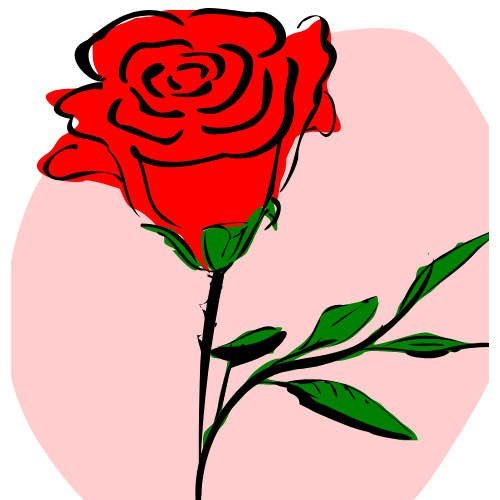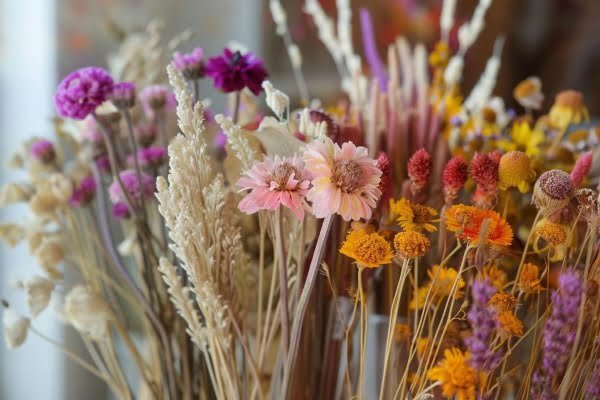


Dried flowers have long been cherished for their beauty, but their value goes far beyond mere aesthetics. Throughout history, dried flowers have been used in various cultures for their healing properties, making them an integral part of traditional medicine and holistic practices. In recent years, there has been a resurgence of interest in the therapeutic uses of dried flowers, as more people turn to natural remedies for physical, emotional, and spiritual well-being. This article delves into the healing properties of dried flowers, exploring how they can be used to promote health and wellness in a variety of ways.
Dried flowers have been used in healing practices for thousands of years, with their roots tracing back to ancient civilizations such as Egypt, Greece, China, and India. These cultures recognized the potent properties of flowers and plants, often drying them to preserve their medicinal benefits.
1. Ancient Egypt: Egyptians were known for their extensive use of flowers in medicine, cosmetics, and religious rituals. Dried flowers like chamomile, rose, and lavender were often used in their healing ointments and oils. The process of drying flowers allowed the Egyptians to store these valuable resources for use throughout the year, especially in the preparation of herbal remedies and incense.
2. Traditional Chinese Medicine (TCM): In China, dried flowers have been an essential component of traditional medicine for centuries. Flowers like chrysanthemum and jasmine were dried and used in teas to treat various ailments, including digestive issues, headaches, and anxiety. TCM practitioners believe that dried flowers can balance the body's energy, or "Qi," and help restore harmony to the body's systems.
3. Ayurveda: In India, the ancient practice of Ayurveda has long utilized dried flowers for their healing properties. Flowers like rose and lotus are dried and used in various forms, including powders, oils, and teas, to promote physical and emotional well-being. Ayurveda emphasizes the importance of using natural, plant-based remedies to support the body's natural healing processes, making dried flowers a key ingredient in many traditional treatments.
4. European Herbalism: In medieval Europe, herbalists often used dried flowers as part of their medicinal preparations. Flowers like lavender, calendula, and elderflower were dried and stored for use in infusions, poultices, and tinctures. These remedies were commonly used to treat a wide range of conditions, from skin irritations to respiratory ailments.
Many dried flowers are known for their specific healing properties, which can be harnessed in various ways, such as in teas, bath soaks, sachets, or aromatherapy. Below are some of the most popular dried flowers used for their therapeutic benefits:
1. Lavender (Lavandula angustifolia):
Lavender is perhaps one of the most well-known dried flowers used for its calming and soothing effects. The dried flowers contain essential oils that are known to promote relaxation, reduce anxiety, and improve sleep quality. Lavender is often used in sachets placed under pillows, in bath salts, or in teas to help alleviate stress and insomnia. Additionally, lavender's antiseptic and anti-inflammatory properties make it useful in treating minor skin irritations and burns.
2. Chamomile (Matricaria chamomilla):
Chamomile is another popular dried flower known for its gentle sedative effects, making it a common remedy for anxiety, insomnia, and digestive issues. The dried flowers can be steeped in hot water to make a soothing tea that helps to relax the body and mind. Chamomile also has anti-inflammatory and antimicrobial properties, which can aid in the healing of wounds and skin conditions like eczema.
3. Rose (Rosa spp.):
Dried rose petals are not only beautiful but also possess numerous healing properties. Roses have traditionally been used to soothe the skin, reduce inflammation, and promote emotional well-being. The dried petals can be used in teas, baths, and skincare products to help calm the mind, balance hormones, and rejuvenate the skin. Rose is also known for its ability to open the heart chakra, making it a popular choice for enhancing emotional healing and self-love.
4. Calendula (Calendula officinalis):
Calendula, also known as marigold, is a powerful medicinal flower with anti-inflammatory, antifungal, and antibacterial properties. The dried petals are often used in salves, creams, and teas to treat wounds, rashes, and other skin conditions. Calendula is also believed to promote lymphatic drainage and detoxification, making it a valuable herb in supporting the body's natural healing processes.
5. Jasmine (Jasminum officinale):
Jasmine flowers are often dried and used in teas and aromatherapy for their uplifting and mood-enhancing properties. The sweet, floral scent of jasmine is known to reduce stress and anxiety while promoting feelings of happiness and well-being. Jasmine is also believed to have aphrodisiac properties and is often used in traditional medicine to support reproductive health and balance hormones.
6. Eucalyptus (Eucalyptus globulus):
Dried eucalyptus leaves are commonly used for their respiratory benefits. The leaves contain essential oils that can help to clear congestion, reduce inflammation, and support the immune system. Eucalyptus is often used in steam inhalations, baths, and sachets to relieve symptoms of colds, flu, and allergies. The dried leaves can also be placed in sachets or hung in the shower to create a refreshing and invigorating atmosphere.
7. Hibiscus (Hibiscus sabdariffa):
Dried hibiscus flowers are rich in antioxidants and vitamin C, making them a popular choice for supporting the immune system and promoting cardiovascular health. The dried flowers can be steeped in hot water to make a tart and refreshing tea that helps to lower blood pressure, reduce cholesterol levels, and improve overall heart health. Hibiscus is also known for its anti-inflammatory properties, which can aid in reducing swelling and soothing sore muscles.
8. Elderflower (Sambucus nigra):
Elderflower is a traditional remedy used to support the respiratory system and treat colds, flu, and sinus infections. The dried flowers can be made into teas, tinctures, or syrups to help reduce fever, alleviate congestion, and support the immune system. Elderflower also has diuretic and detoxifying properties, making it a valuable herb for cleansing the body and promoting overall health.

Incorporating dried flowers into your wellness routine can be done in a variety of ways, each offering unique benefits. Here are some modern applications of dried flowers in healing practices:
1. Herbal Teas and Infusions:
One of the most common ways to enjoy the healing properties of dried flowers is by making herbal teas and infusions. Simply steeping dried flowers in hot water allows you to extract their beneficial compounds and enjoy their therapeutic effects. Whether you're looking to relax with a cup of lavender tea or boost your immune system with hibiscus tea, dried flowers offer a natural and effective way to support your health.
2. Aromatherapy and Essential Oils:
Dried flowers can be used in aromatherapy to promote emotional and physical well-being. By infusing dried flowers in carrier oils, you can create your own essential oils and blends to use in diffusers, massage oils, or bath soaks. The aromatic compounds in dried flowers like lavender, jasmine, and rose can help to reduce stress, improve mood, and enhance relaxation.
3. Bath Soaks and Salts:
Adding dried flowers to your bath can create a luxurious and healing experience. Flowers like chamomile, calendula, and rose can be added to bath salts or used on their own to soothe the skin, reduce inflammation, and promote relaxation. Bath soaks infused with dried flowers are an excellent way to unwind after a long day and support your body's natural healing processes.
4. Skincare and Beauty Products:
Dried flowers are often used in natural skincare and beauty products for their healing and rejuvenating properties. Flowers like rose, lavender, and calendula can be infused in oils, creams, and lotions to create nourishing treatments for the skin. These products can help to hydrate, soothe, and protect the skin, while also providing a gentle floral fragrance.
5. Tinctures and Herbal Remedies:
Tinctures made from dried flowers are concentrated herbal extracts that can be used to treat various health conditions. By soaking dried flowers in alcohol or vinegar, you can create potent tinctures that capture the healing properties of the flowers. These tinctures can be taken orally or applied topically to support the body's natural healing processes.
6. Potpourri and Sachets:
Dried flowers can be used to create potpourri and sachets that add a natural fragrance to your home while also providing therapeutic benefits. Placing sachets of dried lavender, rose, or eucalyptus in your drawers, closets, or under your pillow can help to reduce stress, promote relaxation, and keep your space smelling fresh.
7. Floral Waters and Sprays:
Floral waters, also known as hydrosols, are a byproduct of the essential oil distillation process and contain the water-soluble compounds of the flowers. These floral waters can be used as facial toners, room sprays, or added to bath water for a refreshing and healing experience. Dried flowers can also be used to create your own floral sprays by steeping them in water and adding essential oils for extra potency.
8. Healing Rituals and Meditation:
Incorporating dried flowers into healing rituals and meditation practices can enhance your connection to nature and promote spiritual well-being. Flowers like rose and jasmine can be used in rituals to open the heart chakra and promote emotional healing, while lavender and chamomile can be used to calm the mind and deepen your meditation practice.

The healing properties of dried flowers offer a natural and time-honored way to support both physical and emotional well-being. From ancient practices to modern holistic approaches, the use of dried flowers in teas, tinctures, bath soaks, and other applications has proven to be an effective means of harnessing the power of nature for health. Each flower, with its unique properties, brings its own set of benefits, whether it’s calming the mind, soothing the skin, or boosting the immune system. As more people seek out natural remedies and sustainable alternatives to conventional medicine, the appeal of dried flowers continues to grow.
By incorporating dried flowers into your daily routine, you can tap into the ancient wisdom that has been passed down through generations. Whether you are seeking to alleviate stress, enhance your meditation practice, or simply enjoy the beauty and aroma of dried flowers in your home, there is a wealth of ways to benefit from these preserved blooms. The versatility and accessibility of dried flowers make them a valuable addition to any wellness regimen, allowing you to experience the healing power of nature in a simple and effective way.
In an age where natural and holistic health practices are becoming increasingly popular, dried flowers stand out as a timeless and effective option. Their ability to heal, soothe, and rejuvenate has been recognized across cultures and eras, and they continue to hold a place in modern wellness practices. As you explore the many uses of dried flowers, you may find that these humble blooms offer more than just beauty—they provide a connection to the natural world that can enhance your well-being on multiple levels.
This article highlights the profound impact that dried flowers can have on health and wellness, rooted in history yet fully relevant in modern times. By embracing the healing properties of dried flowers, you can bring the benefits of nature into your daily life, nurturing your body, mind, and spirit in a holistic way. Whether you are new to using dried flowers or looking to expand your knowledge, the possibilities are vast and rewarding.